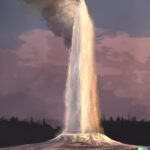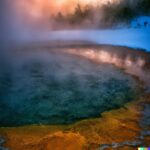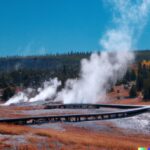Yellowstone National Park: a fascinating natural wonder. In this article, we will explore the unique phenomenon of dormant geysers within the park.
What are dormant geysers? These are geysers that have stopped erupting for a period of time, but still have the potential to erupt again in the future. Understanding the characteristics of dormant geysers is crucial in studying the geological, ecological, and cultural significance of these natural wonders.
Yellowstone National Park is home to some of the most famous dormant geysers in the world, such as Old Faithful and Steamboat Geyser. These geysers have become iconic symbols of the park and attract millions of visitors each year. Discovering the most famous dormant geysers in Yellowstone is a must-do for any nature lover.
So, why are dormant geysers so important? These geysers are not only stunning to look at, but they also play a crucial role in the park’s ecosystem. They provide essential nutrients for plants and animals, and their eruptions can even help regulate the temperature of the surrounding area. Prepare to be amazed by the wonders of nature in Yellowstone National Park, and don’t forget to visit the dormant geysers during your next trip!
What Are Geysers?
Geysers are natural wonders commonly associated with Yellowstone National Park, characterized by their spectacular thermal features and connection to the park’s unique hydrothermal system. These geologic formations are a result of volcanic activity and play a significant role in the park’s geological history.
Geysers are fueled by the underlying hydrothermal system, where water seeps deep into the Earth’s crust and is heated by the magma chamber below. This intense pressure builds until the superheated water and steam explosively erupt, creating the iconic geyser eruptions.
Yellowstone is a living laboratory for studying geothermal phenomena and volcanic activity, as these geysers are a testament to the powerful geological forces at work beneath the surface. It is a fascinating and dynamic landscape, constantly changing and evolving.
Where Is Yellowstone National Park?
Yellowstone National Park, located primarily in the U.S. states of Wyoming, Montana, and Idaho, is renowned for its captivating geothermal energy, which stems from complex geologic processes.
The park is home to an array of natural wonders, including its iconic geysers and thermal features. Yellowstone National Park boasts a unique landscape, thanks to its location on a dormant supervolcano. This geological phenomenon results in stunning hot springs, mudpots, and thermal pools that showcase nature’s artistic prowess.
In addition to its geothermal wonders, the park also boasts a diverse array of wildlife, including bison, elk, and bears. This makes it a popular destination for nature lovers and researchers alike.
What Are Dormant Geysers?
Dormant geysers in Yellowstone National Park refer to formerly active geothermal features that have become temporarily inactive.
These geological formations exhibit reduced thermal activity and are a captivating part of the park’s landscape.
The dormant geysers in the park serve as reminders of its dynamic geothermal environment and complex geological forces.
Despite their current state, these geysers can reactivate as internal pressures and heat fluctuate beneath the surface.
Surrounded by mineral deposits and colorful microbial mats, their unique formations provide insight into the park’s geological history and ongoing thermal processes.
What Causes Geysers to Become Dormant?
The dormancy of geysers in Yellowstone National Park can be attributed to various geologic processes that impact the integrity of their geological formations and contribute to the alteration of their geothermal wonders. These changes result in the temporary cessation of their eruptive activity.
Geologic processes, such as tectonic movements and volcanic activity, are key factors in the dormancy of geysers. These processes can lead to blockages or changes in the underground plumbing systems, resulting in a decrease in pressure and disruption of the eruption cycle.
Additionally, mineral deposition and sediment buildup can also impact the flow of water and behavior of geysers, contributing to their temporary dormancy.
How Many Dormant Geysers Are in Yellowstone National Park?
Yellowstone National Park is home to a notable number of dormant geysers, adding to the park’s array of geologic wonders and demonstrating varying degrees of thermal activity within its unique landscape.
Yellowstone National Park is home to a fascinating array of dormant geysers, scattered throughout the park. These geological wonders provide a glimpse into the park’s history and the processes that have shaped it. From bubbling hot springs to the iconic eruptions of active geysers, the presence of these dormant geysers adds to the diverse thermal activities that astound visitors.
But these dormant geysers are more than just a sight to see. They serve as a testament to the park’s dynamic nature, showcasing the powerful forces at work beneath the Earth’s surface. This makes Yellowstone not only a marvel for nature enthusiasts, but also a valuable destination for scientists studying the Earth’s geology.
What Are the Most Famous Dormant Geysers in Yellowstone National Park?
Among the most renowned dormant geysers in Yellowstone National Park are those that showcase captivating geologic wonders and distinct thermal activity, contributing to the park’s unique landscape and geological features.
These dormant geysers, with their remarkable displays of natural beauty and intricate geological formations, serve as a testament to the park’s rich thermal legacy. Their dormant yet awe-inspiring presence adds an element of mystery to the landscape, drawing countless visitors to witness the raw power and beauty of nature.
Their intricate network of underground plumbing and thermal reservoirs creates a dynamic ecosystem, sustaining diverse flora and fauna that have adapted to thrive in this unique environment.
Old Faithful Geyser
Old Faithful Geyser stands as one of the most iconic dormant geysers in Yellowstone National Park, renowned for its captivating geologic wonders and significant thermal activity. These contribute to the park’s unique landscape and geological features.
The geyser’s eruptions occur approximately every 90 minutes, showcasing the remarkable power of nature and drawing countless visitors annually. Its consistent and predictable eruptions have captivated travelers for generations, making it a must-see attraction in the park.
The thermal activity around Old Faithful Geyser has contributed to the formation of the park’s distinct hydrothermal features, adding to the overall allure of Yellowstone National Park as a haven for geologic enthusiasts and nature lovers.
Castle Geyser
Castle Geyser is among the notable dormant geysers in Yellowstone National Park, characterized by its captivating geologic wonders and distinct thermal activity, contributing to the diverse landscape and geological features of the park.
Castle Geyser stands as a testament to the natural forces at work. Visitors are mesmerized by its imposing structure and the history held within its mineral deposits and eruptions.
The geyser’s cone, resembling a castle, adds to its allure. The surrounding area is adorned with vibrant ecosystems sustained by the geothermal heat. The eruptions of Castle Geyser are a spectacular display of the earth’s power, showcasing its ongoing role in shaping Yellowstone’s extraordinary and unique terrain.
Grand Geyser
Grand Geyser holds prominence as one of the remarkable dormant geysers in Yellowstone National Park, renowned for its captivating geologic wonders and significant thermal activity. These features contribute to the park’s unique landscape and geological formations.
The eruptions of Yellowstone’s geyser can reach heights of up to 200 feet, showcasing the powerful forces beneath the earth’s surface. Its mesmerizing thermal activity, with an intricate network of geothermal features, highlights the dynamic geological processes that have shaped the park over thousands of years.
This fascinating display of nature’s raw energy adds to the allure of Yellowstone, drawing visitors from all over the world to witness this extraordinary part of the Earth’s natural history.
Riverside Geyser
Riverside Geyser stands as a captivating dormant geyser in Yellowstone National Park, acclaimed for its notable geologic wonders and distinct thermal activity, contributing to the park’s diverse landscape and geological features.
Yellowstone National Park is home to one of nature’s most captivating displays – the Old Faithful geyser. Erupting every 6 to 7 hours, this geyser reaches heights of up to 75 feet, leaving visitors in awe. Located along the picturesque Firehole River, the geyser’s setting only adds to its allure. As a key component of the park’s geothermal activity, Old Faithful is a symbol of the powerful geological forces at work beneath the surface, showcasing the dynamic nature of Yellowstone’s landscape.
Daisy Geyser
Daisy Geyser adds to the allure of dormant geysers in Yellowstone National Park, known for its captivating geologic wonders and unique thermal activity. This contributes to the park’s diverse landscape and geological features.
Its dormant state is a testament to the powerful forces beneath the surface. Visitors can admire the intricate mineral formations and colorful algae that adorn its basin.
The geyser, while not currently erupting, still serves as a reminder of the park’s dynamic thermal environment and its role in shaping the land over millions of years. Daisy Geyser showcases the ongoing geological processes that have left an indelible mark on Yellowstone’s awe-inspiring terrain.
What Are the Characteristics of Dormant Geysers?
Dormant geysers exhibit distinct characteristics, including infrequent eruptions, lower temperatures, and altered appearances, contributing to the varied thermal features and geologic formations within Yellowstone National Park.
These geysers lie in a state of rest, with eruption intervals spanning decades or even centuries. Their lower temperatures result in less explosive eruptions compared to active geysers.
The altered appearances of dormant geysers often include sinter formations and unique mineral deposits, adding to the park’s diverse landscape. Despite their dormancy, they still play a significant role in the park’s thermal activity and contribute to the ongoing geological processes that shape Yellowstone’s natural wonders.
Infrequent Eruptions
Dormant geysers are characterized by infrequent eruptions, which contribute to the preservation and unique formation of the associated geologic features within Yellowstone National Park.
These sporadic eruptions play a vital role in maintaining the integrity of geologic formations by preventing mineral build-up that could obstruct their distinct features.
The intermittent release of pressure through these eruptions helps to prevent potentially catastrophic geothermal events, ensuring the long-term stability of the geysers and their surrounding geological landscape. As a result, the infrequency of these eruptions not only shapes the physical features of the park but also sustains the delicate balance of its underground volcanic activity.
Lower Temperatures
Dormant geysers are characterized by lower temperatures compared to active geysers, influencing the unique thermal features displayed within Yellowstone National Park.
This drop in temperature during dormancy alters the behavior of the geysers, affecting the frequency and intensity of their eruptions. As a result, the thermal features that rely on the consistent flow of hot water and steam may experience changes in their appearance and activity levels.
The contrast between the dormant and active geysers also contributes to the diverse and dynamic thermal landscape of the park, showcasing the impact of temperature variations on its geological allure.
Altered Appearance
Dormant geysers exhibit altered appearances that contribute to the diverse and captivating geologic formations within Yellowstone National Park.
The unique processes of silica deposition shape the landscape over time, resulting in colorful terraces and intricate mineral formations. These dormant geysers leave behind evidence of their activity, with mineral deposits creating otherworldly textures and patterns that attract visitors from all corners of the globe.
The altered appearances of these geysers serve as a testament to the dynamic and evolving nature of the park’s geology. Exploring its diverse features inspires awe and wonder in those who witness its ever-changing beauty.
Why Are Dormant Geysers Important in Yellowstone National Park?
Dormant geysers hold significant importance in Yellowstone National Park due to their geological, ecological, and cultural significance, contributing to the park’s rich heritage and diverse natural landscapes.
The geological significance of dormant geysers lies in the unique processes that form them, providing valuable insights into the earth’s inner workings. These geysers also support a diverse range of flora and fauna, playing a crucial role in maintaining the delicate ecological balance of the park.
Culturally, these dormant geysers have been revered by indigenous tribes and early explorers, adding to the park’s mystique and allure. It is essential to preserve and understand these geysers for the park’s continued conservation efforts and for the enjoyment of future generations.
Geological Significance
The dormancy of geysers holds geological significance, influencing the formation of distinct geologic features and contributing to the diverse array of geothermal wonders within Yellowstone National Park.
Dormant geysers are a crucial factor in shaping the landscape of the park. During their inactive state, mineral deposits accumulate and contribute to the formation of terraces, hot springs, and other unique features.
While these geysers may be dormant, their underground chambers still impact the flow of geothermal activity, ultimately shaping the geologic composition of the area. Their presence serves as a reminder of the powerful forces at work beneath the surface, creating the breathtaking terrain of Yellowstone.
Ecological Significance
Dormant geysers bear ecological significance, contributing to the preservation of geothermal resources and the formation of captivating geologic wonders within Yellowstone National Park.
These inactive geysers play a crucial role in maintaining the balance of geothermal systems. By holding reservoirs of hot water and steam underground, they prevent excessive release of geothermal energy.
Their presence influences the deposition of minerals, which contributes to the creation of mesmerizing terraces and other unique geological formations. The dormant geysers serve as a testament to the dynamic forces at work beneath the Earth’s surface, adding to the park’s allure and scientific value.
Cultural Significance
Dormant geysers hold cultural significance, influencing the park’s thermal landscape and contributing to the rich heritage associated with the geologic processes within Yellowstone National Park.
Their presence serves as a reminder of the powerful natural forces at work beneath the park’s surface, shaping its captivating features over millennia.
The ancient tales and legends of the Native American tribes who once inhabited these lands often revolve around the awe-inspiring displays of thermal activity, further underscoring the deep cultural connections to these dormant geysers.
Visitors to the park are not only treated to breathtaking geothermal spectacles but also given a unique opportunity to delve into the historical and cultural narratives embedded in this extraordinary natural wonderland.
Frequently Asked Questions
What are dormant geysers in Yellowstone National Park?
Dormant geysers are geysers that have stopped erupting and have been inactive for a significant amount of time in Yellowstone National Park.
Why do geysers become dormant in Yellowstone National Park?
Geysers become dormant due to changes in the underground water supply or changes in the temperature or pressure of the water.
Can dormant geysers in Yellowstone National Park become active again?
Yes, dormant geysers can become active again if the conditions that caused them to become dormant change, such as an increase in water supply or a change in temperature or pressure.
What is the difference between dormant and extinct geysers in Yellowstone National Park?
Dormant geysers have temporarily stopped erupting but can become active again, while extinct geysers will never erupt again due to permanent changes in their underground water supply.
How many dormant geysers are there in Yellowstone National Park?
There are over 1,200 geysers in Yellowstone National Park, and a small percentage of them are currently dormant.
Are dormant geysers still worth visiting in Yellowstone National Park?
Yes, dormant geysers can still be fascinating to visit as they often have unique formations and can provide insight into the ever-changing geological processes in Yellowstone National Park. However, there is no guarantee that they will become active again.
Last Updated on February 7, 2024 by Jon Waraas – Originally Posted: January 25, 2024

I’m Jon Waraas, and I’ve been navigating the online world since 2006. By day, I’m the proud owner of some eCommerce gems, and by night, I’m the voice behind the adventures on Waraas.Com.
My heart, however, belongs to the wild beauty of Yellowstone National Park. I’ve got a collection of websites dedicated to sharing the wonders of this natural masterpiece. Oh, and did I mention? I’m currently building my own cabin inside the ghost town of Gilmore, Idaho – a cabin with tales to tell!
When I’m not immersed in the digital realm, you’ll find me lacing up my boots for a good hike or setting up camp under the star-studded sky.




